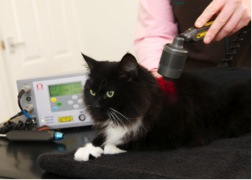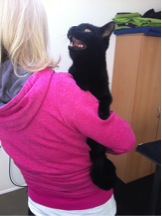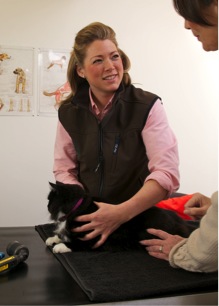Laurie's Blogs.
Mar 2015
Guest Blog - MORE on treating cats!

Hi Laurie
I treat a lot of cats at my practice and they make absolutely wonderful patients!
My advice would be:
Ask the owner to bring in favourite treats – these help as a distraction if needed.
Cats like to be high up, so treat them on your examination table, put down a warm comfy blanket so they can chill while you are treating.
Let the cat cruise and investigate your treatment room before you go near him, that way he will have assessed the room for danger and he'll know of "safe places" to go to if he feels under pressure (usually behind a desk or chair).
When picking up a cat that has suspected musculoskeletal problems, you need to squat down to the cat, put one hand under their ribcage, and the second hand has to scoop up the hindquarters before you lift them off the ground, otherwise you can cause pain in the lumbar region. Once you have "scooped the cat into your arms, bring the cat to your body like a baby, then stand up straight. Don't lift the cat and stand at the same time, this is scary and disorientating.

A cats muscle mass and tone is finer and less dense than a dog, so you have to change your expectation of how healthy muscle should feel.
Most cats will have a bulbous abdomen, they rarely feel tight and toned, like a dog might.
A cat will usually tense during RoM assessments so it can be hard to judge.
Cats carry a lot of tension at the base of their tails, their gluteals, and into their bicep femoris, especially if there is lower back pain and hip issues.
Cats are naturally more sedentary in the winter and their weight can therefore change accordingly.
Cats purr as a self-soothing mechanism, it can mean they are stressed. They can also pant and if very stressed they will have an open mouth.
Just like a dog, let a cat sniff you when you first meet, don’t be afraid to put your head close to theirs so they can have a good old smell of you.
Cats don't show pain and their muscle isn't as reactive as a dogs, I find you have to build a picture of the problem and sometimes be a little 'presumptive' in your diagnosis as a result.
Owner feedback on post treatment behaviour/movement patterns is crucial, for example; the cat starts jumping on the bed again/seeks company more/greater self care and grooming.
If you make your treatment a place of calm, love and cuddles, the cat will come to love coming and will fall asleep on the treatment table.
A cat is far less tolerant of being pushed into pain, so never force a stretch or bodywork on a cat, they will remember and they wont like you next time.
It is highly unlikely a cat will go from neutral to a bite or scratch – they'll be some "mock" bites and head turns first, so keep an eye on body language and head posture.
Cats will crouch down on all fours, if an owner can give them a treat, it will make the cat stretch his neck down and forwards, while the cat is in this position, it becomes easier to assess cervical and cranial thoracic vertebrae.
If you have a cat coming in, ask the next dog client to be respectful of the cat and ask them to wait in their car before coming in, a dog in the waiting room while a cat is being treated is a highly stressful experience for a cat. Having a notice up will help.
Hope this helps – enjoy!
Dani



